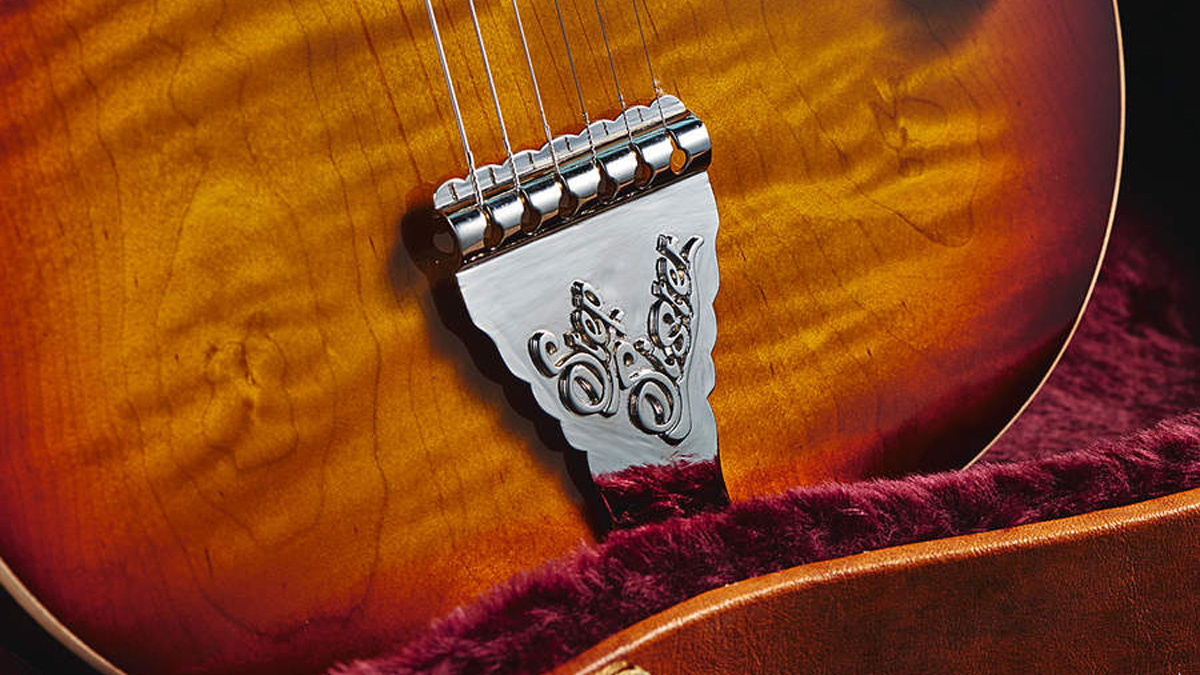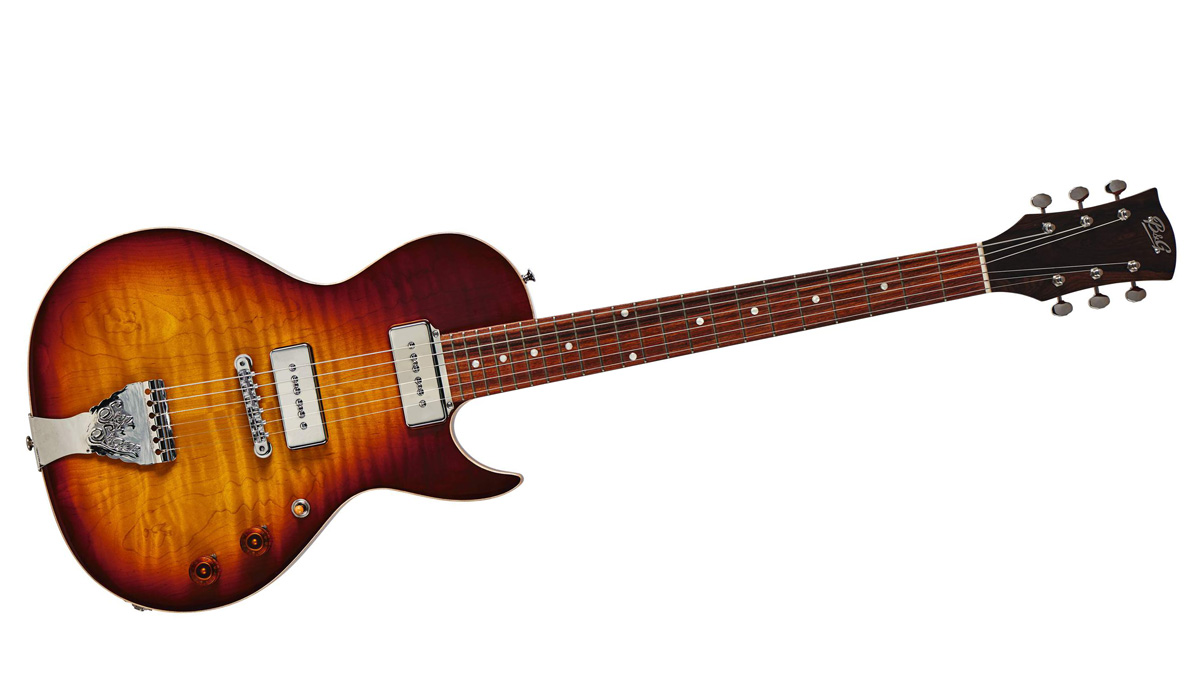MusicRadar Verdict
The ‘modern’ Step Sister is a fine example of small-scale, vintage-rooted luthiery.
Pros
- +
Beautiful old-school build and understated design, unique hardware and a musical voice.
Cons
- -
A slightly bigger fretwire would appeal. Although we admire it, it’s still an expensive punt.
MusicRadar's got your back
The modern guitar market is an incredibly diverse place.
Along with the many brands that clone (and copy) a small number of classic designs there are plenty more operations, large and small, offering something a little different. And talking of different, while a non-cutaway electric with a 14-fret neck and a price veering close to £4k might seem niche, that’s exactly the premise of B&G’s original Israeli-made Little Sister.
Thankfully, to cater for us poverty- stricken wannabe blues and roots players, B&G now offers a Chinese-made version – in both non-cutaway and cutaway styles – aptly named the Crossroads. And, if you do actually reach past the 12th fret, B&G’s latest model, the Step Sister, offers all the build quality, style and mojo of the original Little Sister, but with a neck that joins the body at the 16th fret. So let’s take a look at the Step Sister.
Design and electronics
Lightweight, comfortable and unique certainly encapsulates the style here. The guitar has a Gibson-style scale length and a cutaway outline that might have originated from a parlour style but remains very close to a slab-bodied first series Gibson Les Paul Junior or Special.
The bridge sits lower on the Step Sister sits at approximately 188mm. Aside from the thin (5mm) maple top, the rest of the Step Sister’s body is a single piece of mahogany, which almost feels semi hollow due to the overall lighter weight. The top appears to be bound, but it’s simply the natural edge of the maple (an idea, of course, popularised by Paul Reed Smith), which is mildly grained with a hint of a fairly deep flame as you move the top in the light.
This classicism continues with the one-piece of quartersawn mahogany for the neck, topped with a lightish brown pau ferro fingerboard comprising slightly flecked white pearloid dots, a 305mm radius and small-widthed but relatively high frets. The finish in nitrocellulose will appeal to the vintage-minded - it’s not too flat or shiny, which adds to the handmade vibe.
There’s little modernism to the hardware not least the trapeze tailpiece with its raised model logo, while the tune-o-matic - both fabricated by B&G from brass - screws directly into the body.
And don’t expect anything fancy in the electronics - we get a pair of B&G Kikbuckers (a stacked coil humbucker design conceived by Yotam ‘Kiki’ Goldstein) in nickel-plated brass covers, a three-way toggle, master volume and master tone. Removing the nickel-plated control cover from the back shows off CTS 500k pots and B&G .022microfarad tone cap, all wired vintage-style. In fact, while it is a very vintage-style piece, it puts function at the forefront - with only the somewhat over-fancy metal jack plate being an unnecessary stylistic flourish.
Sounds and Feel
This neck has what B&G calls a ‘soft V profile’ that, with a contemporary comparison, is not a million miles away from PRS’s original ‘wide fat’ shape, sharing a similar depth, virtually identical nut width and string spacing that becomes subtly more flared as it meets the body. It’s a little more V’d along its length, which continues into the boat bow heel. The 14-fret Crossroads is similar, although it rounds out a little more; the heel is more rounded and the V is less pronounced (and even more ‘wide fat’, if we’re honest).
It features a small width fretwire, which adds to the old-school feel. It could do with a good final fret buff and polish, especially for a guitar that comes in at nearly £4k. For now, we can only assume that’s an oversight...
The single action truss rod (access to which is under a cover plate between the neck pickup and the end of the fingerboard) “requires a smaller channel in the neck, which means there is more wood which all helps with the sustain and the tone you hear,” says B&G’s Avi Goldfinger. “When you install it with enough tension you can play with it both ways.”

The Step Sister came with a pretty standard 0.012in relief. String height is modern-standard on the Step Sister (1.6mm on both treble and bass at the 12th).
So what can the Step Sister bring with its enhanced playability and elevated cost? Plugged in after the recently-reviewed B&G Crossroads, rather like when you engage a coil split on a humbucker, it sounds rather weak and thin. Both Kikbuckers have the poles pulled up quite high and, plugging in our ’57 Les Paul Jr (with a lower DCR on its single bridge P-90), it’s chalk and cheese. The Franz-style P-90s of a contemporary Guild M-75 (which is a hollowbody) also leave the considerably more expensive Step Sister at the start line. What are we missing?
How about that the Step Sister, certainly with these humbucking P-90 style pickups, sounds rather unique. It’s lower-than-expected output sits well with our ’69 Telecaster, but the sound, although clearly single coil-like, has considerable depth and a smooth high-end that is bell-like yet not over percussive (like a Strat can be for example). Push it and hit hard, and you certainly go in that direction. Relax a little, pull back the tone and it’s a clear, articulate jazz sound - there’s a tuxedo sheen that elevates jazzy blues licks and voicings to a really sophisticated level.
Show it some hair and dirt, though, and that slight roundness to the attack, along with the depth, suggests a cleaner PAF style, not least with these unpotted pickups, that sounds more grown-up, without the raw edge of the Junior’s gutsier voice. It works superbly with even a basic pedalboard, not least with a boost engaged. It’s very dynamic, clean but not thin, and, once you get its measure, is very hard to put down.
There’s more than a refreshing change here in that B&G is clearly drawing on different influences and not just offering us (yet) another shade of the Les Paul, SG, Strat or Telecaster.
The ‘modern’ Step Sister is a fine example of small-scale, vintage-rooted luthiery. It’s a beautifully considered piece that really has, not least with these P-90 Kikbuckers, a unique and hugely musical voice.
The problem for many will simply be the price. Even if you have £4k to spend, the Step Sister is competing with a huge percentage of high-end makers and you’re really going to have to be sure it’s ‘the one’.
Dave Burrluck is one of the world’s most experienced guitar journalists, who started writing back in the '80s for International Musician and Recording World, co-founded The Guitar Magazine and has been the Gear Reviews Editor of Guitarist magazine for the past two decades. Along the way, Dave has been the sole author of The PRS Guitar Book and The Player's Guide to Guitar Maintenance as well as contributing to numerous other books on the electric guitar. Dave is an active gigging and recording musician and still finds time to make, repair and mod guitars, not least for Guitarist’s The Mod Squad.
"Fender will not get preferential treatment": Reverb has been sold by Etsy to investors in Fender and SoundCloud - but says its partnership with the guitar manufacturer "remains unchanged"
“If they were ever going to do the story of Nero, probably the most decadent of all the emperors, they would have to use Roy Thomas Baker”: Tributes to the legendary producer of Queen, Alice Cooper, Journey and more, who has died aged 78
“Built from the same sacred stash of NOS silicon transistors and germanium diodes, giving it the soul – and snarl – of the original”: An octave-fuzz cult classic returns as Jam Pedals resurrects the Octaurus











